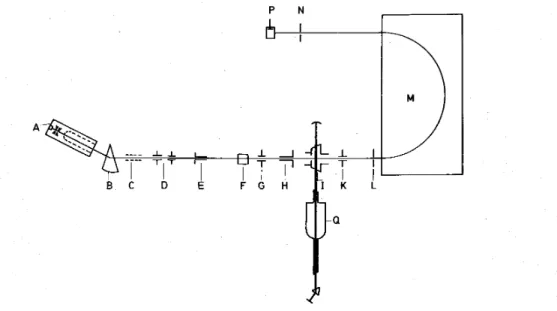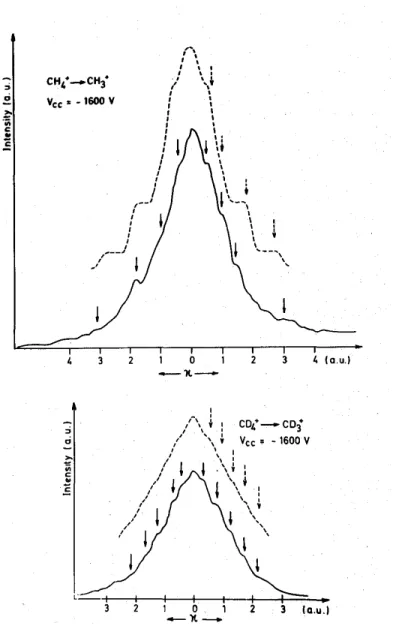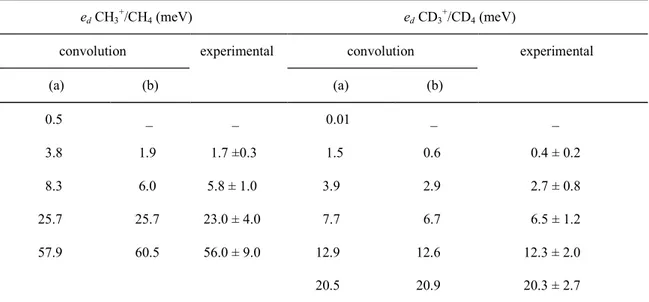THE ROTATIONAL PREDISSOCIATION OF THE CH
4+AND CD
4+IONS
J.P. FLAMME 1, H. WANKENNE, R. LOCHT, J. MOMIGNY
Institut de Chimie, Département de Chimie Générale et de Chimie Physique, Sart Tilman par B-4000 Liege I, Belgium
P.J.C.M. NOWAK and J. LOS
FOM-Instituut voor Atoom- en Molekuulfysica, Amsterdam/Wgm, The Netherlands
Abstract
The metastable transitions producing CH3 + /CH4 + and CD3 + //CD4 +
have been investigated by means of translational spectroscopy. For the first time structures are observed in a metastable peak corresponding to the dissociation of a polyatomic ion. They are interpreted by tunneling through a rotational barrier from discrete quasi-bound states. Kinetic energy releases have been measured.
1. Introduction
A number of publications has been devoted to the metastable transitions corresponding to the loss of H or D from the CH4+ ion and its deuterated derivatives
CH4+ → CH3-+ H.
The observation of the unimolecular decomposition of the CH4 +
and CD4 +
ions, characterized by lifetimes in the range of 10-7_ 10-5 s, was firstly questioned [1,2,4]. Ottinger [3] discovered and Hills et al. [5] confirmed these and pointed out the preferential loss of a H atom in the unimolecular dissociation of partially deuterated methane ions.
The existence of these metastable CH4+ ions have tentatively been predicted in the frame of the
quasi-equilibrium theory (QET). However, only shorter lifetimes could be calculated (10-8 s) [5]. The QET might in fact not apply to the dissociation of the small CH4
+
ion [4—6] ; furthermore, using ICR spectroscopy, Smith and Futrell [7] recently measured lifetimes of 10-3 s for CH4+ molecular ions, which still remain unexplained in the
frame of this theory; finally, our measured appearance energies indicate that the appearance mechanism of the metastable transition would not be due to the threshold dissociation rate constant as supposed by QET.
Rosenstock [4], Klots [9] and Hills et al. [5] introduced a tunneling effect or a reflection above a barrier to predict longer lifetimes. Klots [9] proposed tunneling through a rotational barrier and showed the lifetimes to be equal for the loss of H or D. We intend to detail this behaviour in the frame of a theoretical model described in a following paper [19]. The rotational barrier can easily account for the temperature effect observed by Solka et al. [10] on the kinetic energy release.
The aim of this work is to complete the results obtained with Nier-type ion sources [8,10] by the use of a monoplasmatron source characterized by a higher working temperature. The tandem mass spectrometer previously used to examine rotational predissociation of diatomic ions [11—13] was appropriate to investigate under high resolution, the same process occurring in the CH4
+ and CD4 + molecular ions. 2. Experimental 2.1. Apparatus
The experimental setup (see fig. 1) used in this experiment has been described previously in detail [11]. Briefly, CH4
+
(or CD4 +
) ions are created in a monoplasmatron ion source (A). The energy spread of the ion beam is reduced by monitoring and keeping constant (i) the gas flow of pure CH4 (or CD4) gas and (ii) the plasma
1
oscillations which are maintained as low as possible. The primary ion beam is mass selected by a 30° preselection magnet (B). Lenses (C), deflection plates (D) and collimator (E) focus the ion beam on the entrance hole of a 17.5 cm long interaction chamber (F). By means of plates (G) and (K), the ion beam is directed on a 0.1 cm hole (L). The excess energy of some quasi-bound vibro-rotational level above the dissociation limit will be released as kinetic energy of the neutral and ionized fragments. The hole (L) is used to skim off the larger angles in the center-of-mass system, allowing only the observation under reduced angle of the forward-backward distribution by scanning magnet (M). This inhomogeneous magnet focusses the ions on a 0.03 cm slit (N) before reaching a Bendix electron multiplier. In the present experiment a laser (Q) crossing the ion beam in a chamber (I) has not been used.
While the ion beam is extracted and accelerated through 8.4 kV potential difference, a high voltage of —1.6 kV is applied to the interaction chamber (F). The working pressure in the primary selection region is about 3.0 X 10-6 torr. Pressures of 3 X 10-8 torr and 1.2 X 10-10 torr are measured respectively in the interaction chamber and in the momentum analysing region.
Fig. 1. Schematic outline of the apparatus. For details see text.
2.2. Principle of measurements
A voltage is applied to the interaction chamber (F) to separate the fragment momentum distribution spectrum observed in the interaction chamber from the dissociations occurring along the whole ion beam path between the preselection magnet and the entrance hole of the momentum analyzer (L). Because of the difference between the deceleration of the parent ions upon entering the interaction chamber and the acceleration of the fragment ions upon leaving it, the image of the chamber will shift on the momentum scale with respect to the spectrum arising from the whole field free region, which follows quantitatively from eq. (1) below. To achieve this purpose in the mass range of interest, an unusual high voltage of - 1.6 kV had to be applied. Consequently the interaction chamber acts as a lens which must be considered.
In order to get experimental data which can be compared with theory, a deconvolution of the laboratory measurements is necessary [11,14-16]. Due to the finite angular resolution of the apparatus, peaks arising from dissociation fragments with low momenta are smeared out towards the centre of the spectrum. Thus in the case of CH4
+
and CD4 +
, where the fragment velocities are very small, a deconvolution is inevitable. However Maas et al. [17] showed that a convolution rather than a deconvolution is required, especially for very low fragment velocities. The convolution consists of a computer program which simulates the apparatus effects. Starting from real dissociation energies, it computes a theoretical spectrum which has to be compared with the experimentally observed one. Because of the high voltage on the interaction chamber (-1.6 kV) the program has been modified to account better for the focussing properties of the interaction chamber and thus the better angular resolution of the apparatus. Due to the enhanced angular resolution, the fragments of CH4
+
and CD4 +
still lead to structure in the mass spectrum although from geometrical considerations these low momenta in the centre-of-mass system only would lead to a single broad peak.
From fig. 2 it seems that some peaks are shifted outwards. This is caused by a change of scale of the momentum spectrum. The laboratory momentum of a fragment originating from the interaction chamber, in second order Taylor approximation is given by:
(1)
where V0 is the acceleration voltage and Vcc the voltage applied to the interaction chamber. M and m are the
masses of the parent ion and the fragment ion respectively. K0and κ are the momenta, respectively, of the parent
ion before entering the interaction chamber and of the fragment. This equation applies only to forward and backward dissociation with respect to K0.The second term of eq. (1) shows that in the case of CH4
+
the scale of the centre of the mass spectrum is expanded by 10%. The first term demonstrates that the centre of masses is shifted to lower values, using a negative Vcc. This is only true for fragments which arise from dissociations
occurring in the interaction chamber. This effect provides a way to compute roughly a lifetime criterion for the metastables, according to the time of flight from the source to the interaction chamber (≈ 5 x 10-6 s).
Fig. 2. Observed (—) momentum distribution spectra of CH3+/CH4 and CD3+/CD4 from metastable dissociation
in the interaction chamber. The corresponding convoluted (—) momentum spectra are superposed. Full arrows indicate the measured shoulder positions, dotted arrows give the actual positions before the convolution.
2.3. Data analysis
Due to the resolution obtained in the measurements, the momentum distribution spectra of CH3 +
| and CD3
+
have been recorded 30 times. The quantity to be obtained, i.e. the released kinetic energy ed, is deduced
from the measurements of momentum κ. The error sources on this quantity are (i) the calibration error and (ii) the scattering of the measurements with respect to the arithmetic mean value. The energy ed being related to κ
through
the error is
∆κ is given by the sum of the standard deviation on κ and the calibration error. 3. Results and discussion
3.1. Experimental results
Typical experimental momentum distribution spectra of CH3 +
and CD3 +
are shown in fig. 2 (full lines). Several shoulders are detectible in the peaks. The corresponding average kinetic energy ed values are listed in
table 1. The described convolution method (see section 2.2) has been applied to a set of discrete kinetic energy values involved in processes of equal cross section. The real theoretical values listed in column 1 of table 1 (dashed arrows in fig. 2) give rise to a convoluted peak shown in fig. 2 by dashed lines. The position of the shoulders are given in table 1, column 2, and have to be compared with the measured values (full line arrows) listed in column 3 of table 1.
3.2. Discussion
From the present experiments, two important features have to be discussed: (i) the observation of a structured metastable peak and (ii) the small amount of released kinetic energy, which can be explained by the rotational predissociation.
For diatomic ions, the rotational predissociation gives metastable peaks with a well-resolved structure. Only a few quasi-bound states, the lifetime of which are in the correct range, appear in the metastable peak (see H2
+
, HeH+, He2 +
,in ref. [11-13]).
For polyatomic ions, where a priori all the vibrational modes would be coupled, it would not be possible to observe isolated quasi-bound states. Tunneling would be allowed for all energy values above the dissociation limit and for any barrier height. A quasi-continuum of vibro-rotational levels would give rise to a continuous kinetic energy distribution. Consequently no structure would be observed in the metastable peak.
However, the experimental metastable peaks clearly show the existence of isolated quasi-bound states as in the diatomic case. This is only possible if the coupling between the characteristic vibration of the CH3
+
— H bond and the other ones is weak.
3.2.1. Lifetimes calculations
Tunneling through a rotational barrier can account for a large set of lifetimes, depending on the barrier height and the energy level where tunneling occurs. The metastable transitions are ascribed to dissociations, the lifetime of which is in the range of 10-7-10-5 s.
As will be shown in a following paper [19], it is possible to calculate the rotational barriers from a theoretical model of the CH4
+
ion. The assumed model is a symmetric top ion based on a planar CH3 +
ion and an H atom.
The rotational barrier associated with a dissociation occurring along the main axis of a symmetric top ion is:
J and K being the rotational quantum numbers and I the inertia momentum perpendicular to the main axis. The lifetime of an energy level E is given by
It will be shown that the calculations effectively give possible lifetimes and kinetic energies, within the range of the experimental values. The kinetic energy distribution can be related to the different J, K values given by the rotational distribution function for the CH4+ ions,
This model will also predict the occurrence of long lifetimes as observed by Smith and Futrell [7] (10-3 s).
Some attempts have been made in order to get a diatomic potential of the CH4 +
ion [19]. Using the vibrational spacings published by Rabalais et al. [17], it is possible to calculate a few quasi-bound states in agreement with the experimental results.
3.2.2. Temperature effect
The difference between our experiment and the measurements of Solka et al. [10] can be ascribed to the ion source conditions. The temperature is 400-500 K in Solka's experiments [10] and around 1500 K in the monoplasmatron source. The higher kinetic energy values observed in our experiments would not be detectible at lower temperature, due to the difference in the rotational distribution function of the ions.
Table 1: Comparison of measured and theoretical kinetic energy (ed) values for CH3/CH4 and CD3/CD4
ed CH3 +
/CH4 (meV) ed CD3 +
/CD4 (meV)
convolution experimental convolution experimental
(a) (b) (a) (b) 0.5 _ _ 0.01 _ _ 3.8 1.9 1.7 ±0.3 1.5 0.6 0.4 ± 0.2 8.3 6.0 5.8 ± 1.0 3.9 2.9 2.7 ± 0.8 25.7 25.7 23.0 ± 4.0 7.7 6.7 6.5 ± 1.2 57.9 60.5 56.0 ± 9.0 12.9 12.6 12.3 ± 2.0 20.5 20.9 20.3 ± 2.7
a) Actual kinetic energy value before convolution, b) Kinetic energy value as observed from the convoluted peak.
4. Conclusions
The tunneling mechanism through a rotational barrier is confirmed. The observed structure in the metas-table peaks must be related to a lack of coupling between the vibro-rotational modes of the CH4+ ion. The
basic condition of the QET, i.e. energy randomization by fast coupling between the vibrational modes, would not be fulfilled. The CH4
+
This experiment also provides the first experimental evidence for vibro-rotational predissociation in a polyatomic molecule [18].
Acknowledgement
The authors J.P.F., H.W., R.L. and J.M. gratefully acknowledge Professor J. Kistemaker for the hospitality which made this work possible. The authors also wish to thank the Stichting voor Fundamenteel Onderzoek der Materie, the Nederlandsche Organisatie voor Zuiver Wetenschappelijk Onderzoek and the Belgian Fonds de la Recherche Fondamentale Collective for financial support. One of us (J.P.F.) acknowledges the Belgian Fonds National de la Recherche Scientifique for a grant.
References
[1] CE. Melton and H.M. Rosenstock, J. Chem. Phys. 26 (1957) 568. [2] V. Dibeler and H.M. Rosenstock, J. Chem. Phys. 39 (1963) 1326. [3] C. Ottinger, Z. Naturforsch. 20 (1965) 1232.
[4] H.M. Rosenstock, Advan. Mass Spectrom. 4 (1968) 523.
[5] L.P. Hills, M.L. Vestal and J.H. Futrell, J. Chem. Phys. 54 (1971) 3834. [6] M. Krauss, A.L. Wahrhaftig and H. Eyring, Rev. Nucl. 5 (1955) 241.
[7] R.D. Smith and J.H. Futrell, Intern. J. Mass Spectrom. Ion Phys. 20 (1976) 425. [8] J.P. Flamme, J. Momigny and H. Wankenne, J. Am. Chem. Soc. 98 (1976) 1045. [9] CE. Klots, Chem. Phys. Letters 10 (1971) 422.
[10] B.H. Solka, J.H. Beynon and R.G. Cooks, J. Phys. Chem. 79 (1975) 859. [11] J.G. Maas, N.P.F.B. van Asselt and J. Los, Chem. Phys. 8 (1975) 37.
[12] R. Locht, J.G. Maas, N.P.F.B. van Asselt and J. Los, Chem. Phys. 15 (1976) 179.
[13] J.G. Maas, N.P.F.B. van Asselt, P.J.C.M. Nowak, J. Los, S.D. Peyerimhoff and R.J. Buenker, Chem. Phys. 17 (1976) 217.
[14] P.G.A. Fournier, Methodes de spectroscopie sans largeur Doppler de niveaux excités de systèmes moléculaires simples. Coll. Intern, du CNRS no. 217 CNRS Paris, 1973, p. 169.
[15] S.J. Anderson, J. Chem. Phys. 60 (1974) 3278.
[16] D.J. Terwilliger, J.H. Beynon and R.G. Cooks, Proc. Roy. Soc. (London) 341 (1974) 135.
[17] J.W. Rabalais, T. Bergmark, L.O. Werme, L. Karlsson and K. Siegbahn, Phys. Scripta 3 (1971) 13. [18] G. Herzberg, Electronic spectra of polyatomic molecules (Van Nostrand, New York, 1966) p. 473. [19] J.P. Flamme and J. Momigny, to be published.


